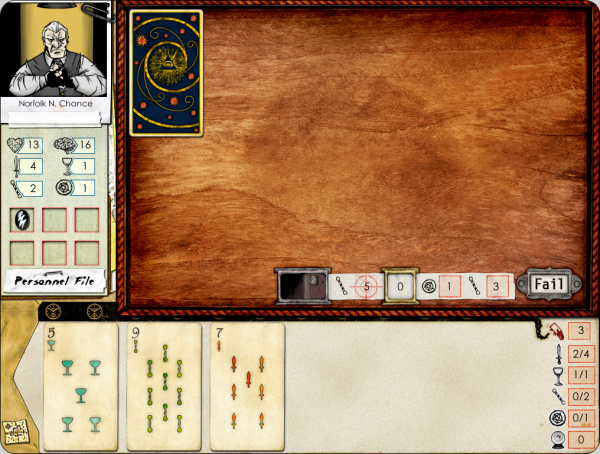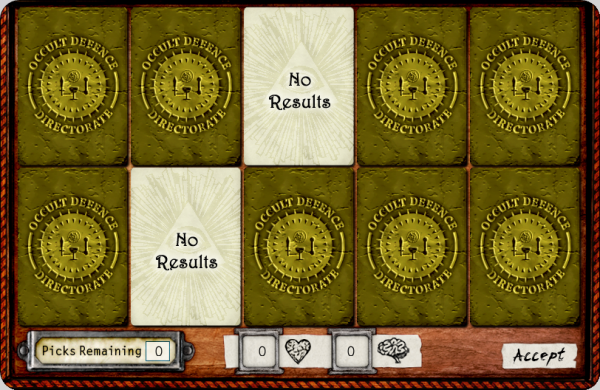
The face down cards represent the tricks to be won. The face up cards at the bottom are the cards we are dealt. I won’t get into the fine details of trick-taking, that’s in the manual. I will say that to win a trick you need a higher value card of the same suit as the trick card that is revealed.
[INDENT]EDIT: Here’s a brief explanation of trick taking:
All non face cards are worth 1 point. Pages are worth 2 points. Knights are worth 3 points. Queens are worth 4 points, Kings are worth 5 points. Major Arcana (A Trump Card) are worth 7 points if they take a trick.
You receive points for both the trick cards taken and the cards played from your hand to take the trick. So if a Page of Swords is played to take a 3 of Swords you will receive 3 points.
If you do not have any cards in your hand that match the suit of the revealed trick card, then you may click on another unrevealed trick card and attempt to match and take it.
You proceed to reveal trick cards and play cards from your hand until you can no longer claim any more trick points. The more trick points that you claim above the target value for success the better your rewards will be during the results phase. Conversely, the fewer points you have compared to the target value for success, the worse the penalties will be during the results phase.
[/INDENT]
So our three drawn cards are 5 of Cups, 9 of Wands, 7 of Swords. The face down trick card must be one of these three suits for us to even have a shot at winning. As the drawn cards are low in value, the odds of winning the trick even with a suit match is slim. The target, again is five points, which is the margin of difference in the value between the drawn card and the trick card when you win a trick.
Revealing the trick card:

So we play the 7 of Swords on this and win the trick. Unfortunately that only nets us two points toward the target of five, so we lose the attempt to activate the door.

At this point, just starting out, the only item we have that could be used to affect the outcome of the challenge is our Remington Shotgun. That, though, can only modify a combat challenge, not a lock challenge, so here it is of no use.
Note that once you get used to playing the challenges, they take a matter of seconds, so it is possible to keep trying to unlock the door in hopes that you’ll get lucky. However each lost challenge presents a chance you’ll be penalized in some way, usually through lost health or sanity, so there is a downside to simply repeating the challenge until you’re successful.
Speaking of luck, the game includes a luck modifier that goes up or down depending on cards drawn as rewards or penalties after a challenge is resolved.
And speaking of rewards and penalties, having lost our attempt to pick the lock, we must choose 2 cards in the penalty phase (the number of cards is roughly akin to how far away you were from your challenge target).

The mostly likely card is ‘No results,” and that in fact is our penalty.

So we emerge from this relatively minor encounter unscathed. Onward!